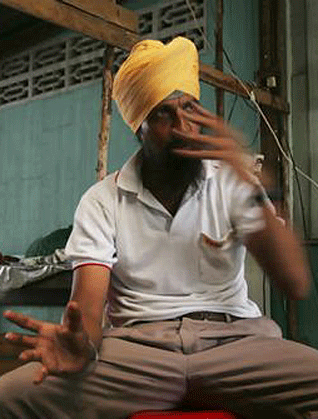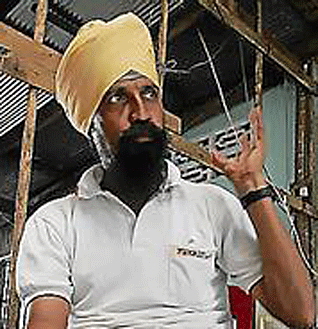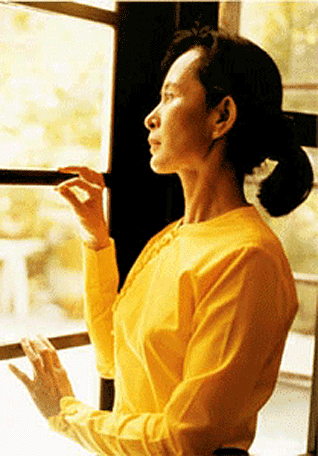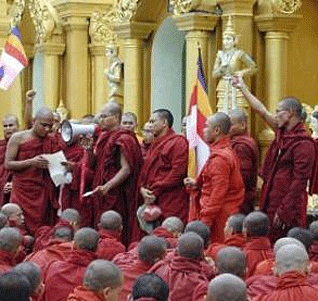People
Burma's U Pancha - "The Punjabi"
by CONNIE LEVETT
Surinder Singh Karkar, an organiser of the protest movement in Rangoon, has blasted the United Nations special envoy, Ibrahim Gambari, for bowing to the junta and gaining nothing in his visit to Burma.
Also known as Ayea Myint and U Pancha ("The Punjabi"), Surinder Singh was among the Burmese who organised civilian protection circles that ringed monks as they marched through the streets of Rangoon for eight days last month.
"Nothing was achieved ... Whatever the regime told him, he did. While he was there, we were being shot, we were being detained. After he left, there was more rounding up of people", the 43-year-old Sikh-Burmese said.
He called on Dr. Gambari to publicly release what the detained opposition leader, Aung San Suu Kyi, had said to him during two meetings in Burma.
U Pancha, a veteran of mass protests in 1988, is now in Mae Sot, where many Burmese opposition groups are based. In his first interview since arriving in Thailand, he gave a rare insight into the first days of the protests, and how the organisers responded as the movement grew.
"I took up the protest again because prices were rising and people were starving around me. I was not at all frightened. I participated in the forefront, I was prepared to die", he said.
He met monks and a few civilians at the Shwedagon Pagoda, the most important Buddhist temple in Rangoon, on Monday, September 17.
"The idea was to bring down petrol prices, to get dialogue and an apology for the way the monks were beaten at Pakokku. There were only about a hundred to start with", he said. "We let the monks lead."
He recalls being "very anxious" on September 18, the first day of the marches. "We were worried whether people would follow us, but from the beginning they joined in; we were very encouraged. That night, we had a hurried meeting because of the support and made three streams of people to go to different points in the city. On the 19th, the groups exceeded 100,000", he stated.
But that night, they got word the military had issued a shoot-to-kill edict. "We had a heated meeting about the next day and the danger. We decided if one stream was shot, the others would come together with it. In the midst of our marching, Battalion 77 refused to take the order to shoot to kill".
From September 21 to 25, the protests were peaceful and the crowds kept increasing. On the night of the 25th, the protesters' informant network let them down. The military command had changed from 77th battalion to 66th battalion. He remembers the next two days as the most bloody.
"We didn't get that information until 10 a.m. on September 26. Within fifteen minutes of getting the news, the army had surrounded us, blocked the four ways out of the pagoda. When three monks went to beg them not to use violence, they started beating the monks and shooting", U Pancha said. "The force became uneven, so we encouraged people to come with weapons - bricks, stones, rocks".
He said that on the 26th, 100,000 civilians marched with 5,000 to 6,000 monks. "People were not scared. I thought we were winning; in the midst of flying bullets we were able to march. We had people in the side streets, with stones and rocks ready to give protection to the protesters".
But on Thursday, September 27, the monks were gone, and the crowd dwindled to between 2,000 and 3,000. "Many people were scared", he said.
"When the Japanese [the photographer Kenji Nagai] was shot, they [knew] the Government would shoot even foreigners". By Friday, the movement had all but disintegrated.
U Pancha waited in Rangoon, hiding until October 4 to see the outcome of the UN mission, then, bitterly disappointed, fled to Thailand. He remains determined to fight on. "I am still a leader, we have leaders inside and outside", he declared. "We are only pausing, not surrendering".
[Courtesy: Brisbane Times. Story suggested by Amandeep Singh Madra.]
Conversation about this article
1: Tejwant (U.S.A.), October 11, 2007, 1:37 PM.
Does any one know how many Sikh families are in Burma and if any of them were affected by these events?
2: Harinder (Pune, India), October 12, 2007, 8:40 AM.
Great to see Sikhs spreading the message of "Born Free" even today amongst the oppressed. I think this is how a Sikh should be: wherever there is a challenge, you will find him/her there, to help those in need! Keep it up, Surinder Singh, we love you.
3: Ruby Kaur (Oxford, England), October 12, 2007, 11:45 AM.
How incredibly brave this man is. And an inspiration to Sikhs outside India - we must devote ourselves to the society we live in, and perform selflessly to better it. He is also so humble and devoted to justice for the people of Burma. A wonderful story and a shining example to us all.
4: Prof. H.S. Virk (Chandigarh, Punjab, India), October 13, 2007, 9:36 AM.
In 2005,I was deputed by the Govt. of India to set up research labs in Yangon University. My article "Sikhs in Burma" was published in The Sikh Review. Sikhs live in Rangoon and Mandalay and do business there, but the brave actions of U Pancha deserve our appreciation. The military junta is very cruel: I recall that I too was spied upon. Even my article in The Sikh Review was not tolerated by the military regime.
5: Sonu (U.S.A.), October 13, 2007, 9:36 PM.
Excellent article, and I concur with many of the comments. This man shows through his brave actions what it truly means to be a Sikh - a human being, born free, is willing to fight against injustice in whatever land he or she considers home ... in this case, Burma.
6: Preetinder Cheema (Australia), October 14, 2007, 6:41 AM.
This is a befitting tribute to the spirit of Sikhism and the fearlessness entrenched in the Sikh psyche by Guru Gobind Singh who deliberately promoted a visibly distinct identity for his followers so that they become fearless and ferocious towards oppressive regimes.
7: Niraj S. Jassy (London, U.K.), November 08, 2007, 4:58 PM.
I have nothing but admiration for the legend that is U Pancha. He shows the very spirit that encompasses his heritage. I pledge my support for his cause and his people. A true inspiration for all.
8: Purinder Singh (Kuala Lumpur, Malaysia), May 10, 2015, 10:33 AM.
I would love to contact S. Surinder Singh. Can anyone help me with his contact info, please? What a great Sikhi spirit he has! I respect his vigor and bravery.
9: Satnam (Darwin, Australia), December 10, 2015, 9:02 PM.
There is a 100 year old gurdwara in Kengtung town (on the Burma-Thai border) which is being looked after by the only Sikh family there. It is in a poor state after the last earthquake, although the site itself is in the town centre. Kengtung is best approached by air from Yangon or from Thailand by land. There used to be a large British garrison in the town with Sikh and other soldiers in the old days. Will we save this gurdwara?






